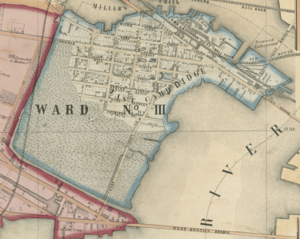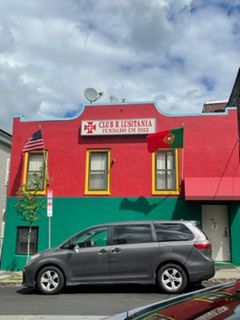East Cambridge, Cambridge, Massachusetts facts for kids

East Cambridge is a busy neighborhood in Cambridge, Massachusetts. It's bordered by the Charles River and the Charlestown area of Boston to the east. To the north, it meets the town of Somerville, Massachusetts. Broadway and Main Street form its southern edge, and railroad tracks are on its western side.
Most of the streets in East Cambridge are laid out in a grid pattern. This grid lines up with Cambridge Street, which was built to connect the area directly to Harvard Square, the heart of Cambridge back in 1809.
The northern part of East Cambridge is mostly a residential area with many homes. Cambridge Street itself is a shopping area, along with Monsignor O'Brien Highway and the Cambridgeside Galleria mall. Lechmere Square is a major spot for public transportation in the northern part of the neighborhood.
The southern half of East Cambridge is very different. It's filled with offices and labs for many technology and research companies. These include firms linked to MIT, biotechnology companies like Genzyme and Moderna, and various small businesses. This part of the neighborhood is often known as Kendall Square. Along the waterfront, you'll find several hotels and tall apartment buildings.
How East Cambridge Grew Over Time
East Cambridge wasn't always connected to the mainland. It used to be an island surrounded by marshland, especially at high tide. The Millers River flowed just to the north. On old maps from the Revolutionary War, this area was called Lechmere's Point. It was even where British soldiers landed before the famous Battles of Lexington and Concord.
People who built Craigie's Bridge helped create the street grid in East Cambridge. By 1844, the island was connected to other places by a few roads. These roads led to Harvard, what is now Kendall Square, and to Charlestown.
The area soon became home to the Middlesex County courthouse. Many different businesses also started here, like factories making soap and furniture. Merchants, lawyers, and all kinds of people lived here, from factory workers in small cottages to wealthy families in fancy homes.
Transportation improved a lot. The Middlesex Canal opened around 1802, helping move goods between Charlestown and Lowell. The Middlesex Turnpike connected Broadway to northern areas around 1810. Later, the Boston and Lowell Railroad started carrying freight in 1835.
More railroads arrived, like the Fitchburg Railroad in 1843 and the Grand Junction Railroad in 1847. These railroads helped bring goods to local businesses. An interesting project called the Meigs Elevated Railway, a steam-powered monorail, even ran here as a demonstration in the late 1800s.
Over time, a lot of the marshland was filled in. This expanded the street grid to almost what it looks like today by the 1920s. This connected East Cambridge better to its surrounding neighborhoods. Only the Lechmere Canal and part of the Broad Canal remained. The Miller's River was almost completely filled in.
From 1895 to 1940, there was a large public park along the Charles River called The Front. Part of it was later sold for new buildings. Another park by the river was replaced by the Museum of Science, which opened in 1951.
In 1978, a plan for the East Cambridge riverfront helped improve the area. Traffic was moved to Commercial Street, making a nicer park area along Cambridge Parkway for people to enjoy. This plan also led to a wider Binney Street, new apartment buildings by the river, and the CambridgeSide Galleria mall.
Since the late 1990s, East Cambridge has changed a lot. Old factories have been turned into new apartments and office spaces. This process is called gentrification. The neighborhood is now seeing many new large buildings being constructed, including the North Point project, which plans for many residential towers. In 2011, several new restaurants opened in the Kendall Square area. The Lechmere Station was also moved to a new location, opening in 2022.
Who Lives in East Cambridge?

East Cambridge is home to many people with Irish and Portuguese backgrounds. You'll also find a mix of Polish and Italian families. Many professionals who work in Boston and Kendall Square also live here.
It's mostly a middle-class neighborhood. Over 96% of the people living here work in "white-collar" jobs, which means they usually work in offices or professional settings rather than manual labor.
In 2019, East Cambridge had about 12,254 residents living in 5,816 homes. The average household income was about $140,245. Most residents (64%) were born in the United States, while others were citizens from other countries or not U.S. citizens.
Since 2005, the average income has gone up, and the value of homes has increased a lot. The growth in the Kendall Square area has brought many new buildings and modern changes to East Cambridge.
Famous People From East Cambridge
Dorothea Lynde Dix was a notable person who lived here. She became a strong supporter for treating people with mental illness kindly. She started volunteering as a Sunday school teacher in East Cambridge during the time before the American Civil War.

